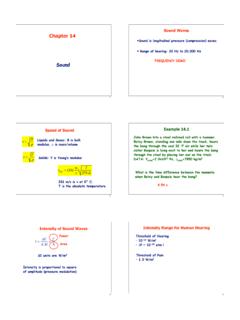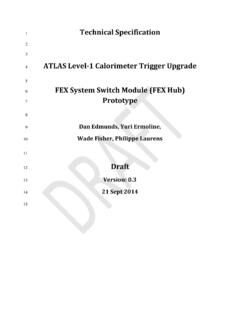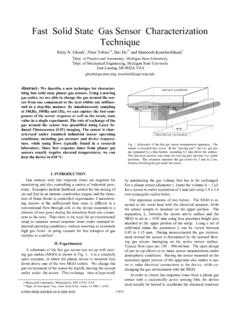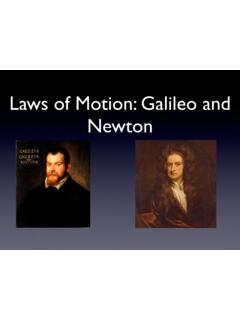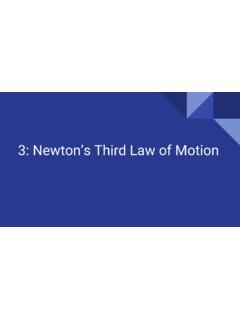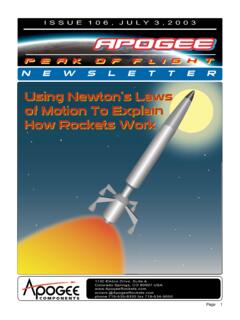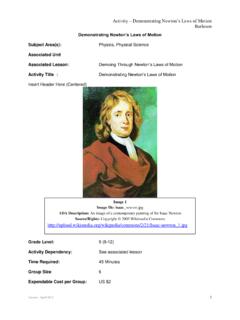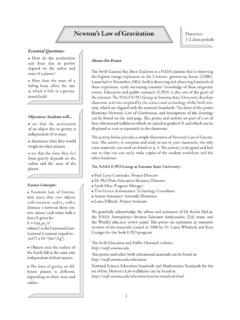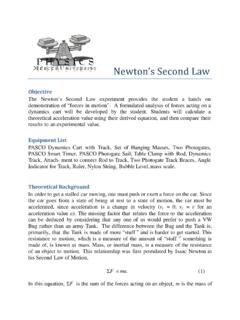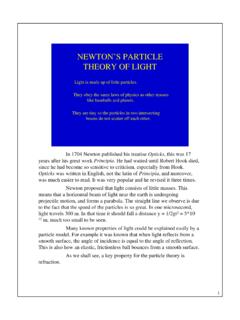Transcription of Newton’s Second Law
1 Experiment4 newton Objectives Test the validity of newton s Second Law. Measure the frictional force on a body on a low-friction air IntroductionSir isaac newton s three laws of motion laid the foundation for classicalmechanics. While each one is important, in today s lab we will test thevalidity of newton s Second Law,F= equation says that whenaforceactsonanobject,itwillaccelerat eandtheamountofaccelerationis dependent on the object s Key ConceptsYou can find a summary on-line at for keywords: newton s laws1 newton s First Law states that an object in a state of uniform motion tends toremain in that state of motion unless an external force is applied. newton s Third Lawstates that for every action there is an equal and opposite TheoryNewton s Second Law states that the acceleration of a body is proportionalto the net force acting on the body (a/FNET)andinverselyproportionalto the mass of the body (a/1m).
2 Combining these two, we can replace theproportionality with equality. That is,a=FNETmorFNET=maFNETis thesum of all of the forcesacting on the body. In manytextbooks this is denoted , newton s Second Lawis:nXi=1F=ma( )The standard SI unit for force is kg m/s2, which is given the nameNewton (N). In this lab it will be more convenient to make measurementsin grams (g) and centimeters (cm) so you will be using the cgs system ofunits : In the cgs system of units, the unit for forceis the dyne:1dyne=1gcm/s2In this experiment a low friction air track will be used to test the validityof newton s Second Law. A hanging mass will be attached to a glider placedon the air track by means of a light (negligible mass) string. By varying theamount of mass that is hanging we will vary the net force acting on this twobody system. While doing this we will make sure to keep the total mass ofthe two body system constant by moving mass from the glider to the the air track turned on, the hanging mass will be released and theglider will pass through two photogate timers.
3 The photogate timers will beused to measure two velocities. Recall thatv= x t. In our case xwill bethe length of a fin placed on top of the glider. If you know the separationbetween the two photogate timers, you can use the following equation todetermine the acceleration of the glider:42 Last updated September 26, TheoryFigure : Freebody diagramsv22=v21+2aSwherev2is the velocity measured with thesecond photogate,v1is thevelocity measured with thefirst photogate,ais theaccelerationandSis the distancebetween the two photogate yields:a=v22 v212S( )Free body diagrams of the forces acting on the glider and hanging massare shown in In the figure,fis the netfrictionalforce acting onthe glider (we will assume this includes both the frictional force betweenthe airtrack and the glider and between the string and the pulley);Nisthe upward force (called the normalforce ) the air track exerts on theLast updated September 26, sSecondLawglider;Tis thetensionin the string;FG=MG gis theweight3of theglider.
4 AndFH=MH gis theweightof thehanging masswheregisthe acceleration due to gravity. Since the air track is horizontal and theglider does not accelerate in the vertical direction, the normal force and theweight of the glider are balanced,N=MG g. Applying newton s SecondLaw to the glider in the horizontal direction and using to the right as thepositive direction yields:T f=MG a( )whereais the acceleration of the glider in the horizontal direction. ApplyingNewton s Second Law to the hanging mass and definingdownwardas thepositive direction yields:MH g T=MH a( )whereais the acceleration of the hanging mass in the vertical that since the glider and hanging mass are attached to each other by astring they are both moving with the same accelerationaand feel the have no way of directly measuring the tensionTin the string, butif we combine tension can be eliminated. plug it into get:MH g MG a f=MH a( )Then rearrange the equation and notice that the weight of the hangingmass,MH g, can be written asFHgiving:FH f=(MH+MG) a( )There are only two unbalanced forces acting on our two-mass system ( weight of the hanging mass,FH, and friction,f).
5 Notice what : the left-hand side is the net force and the right-hand side is theproduct of the system s mass (the mass of the glider plus the hanging mass)3In these equations I am explicitly including an asterisk (*) to indicate multiplicationto avoid confusion between the letters used as subscripts to indicate the object (Gforglider andHfor hanger) and the letters used as variables (gfor acceleration due togravity andafor acceleration).44 Last updated September 26, In today s laband its acceleration. This is newton s Second Law, F=ma, applied toour two body s rearrange obtain:FH=(MH+MG) a+f( ) the same form as the equation of a straight liney=mx+b,where the weight of the hanging mass (FH)playstheroleofyand theacceleration (a)playstheroleofx. Before coming to lab you should figureout what physical quantities the slope andy-intercept correspond to. Ifyou don t remember how to match up the equations refer back to the Introduction to Computer Tools and Uncertainties lab and look at Step 1in the section called Plotting a best-fit line.
6 In today s labToday we will use an almost frictionless air track to measure how forcea ects acceleration. We will measure the velocity of the glider while keepingthe total mass of the system the same (total mass = mass of hanger + massof glider). We ll redistribute the mass by moving it from the glider to thehanger. Using the velocities at both photogates, we will then be able to findthe acceleration of the EquipmentDo not move the glider on the track while the air is turned o ! Air track Glider Hanger 2 Photogates 5g, 10g, 20g massesLast updated September 26, sSecondLawFigure : Diagram of the up the air track as shown in With the hanging massdisconnected from the glider and the air supply on, level the air trackby carefully adjusting the air track leveling feet. The glider should siton the track without accelerating in either direction. There may besome small movement due to unequal air flow beneath the glider, butit should not accelerate steadily in either the length (L)ofthefinontopofthegliderandrecordit along with its uncertainty in your spreadsheet.
7 See a definition of various lengths that will be used throughout sure the hook and counter balance are both inserted in thelowerhole on the the mass of the glider (MG0)andemptyhanger(MH0)and record these masses in your spreadsheet. In today s lab you willneglect any uncertainties in measuring the masses as they are negligiblecompared to the uncertainty in the the 5, 10 and/or 20 gram masses, place 40 grams of mass on theglider. Make sure to distribute the massessymmetricallyso that the46 Last updated September 26, ProcedureFigure : Definition of various lengths used throughout this is balanced on the track and not tipping to one side. Determinethe total mass of the glider (MG0+the mass you just added)andrecord this in your spreadsheet in the column labeledMG. (See theattached spreadsheet.) 10 grams of mass on the hanger. Record this in your spreadsheetin the column labeled Mass added to hanger and then have Excelcalculate the total mass of the hanger (MH=MH0+themassyoujust added to the hanger) in the column that the total mass of your system (MG+MH)shouldremainconstant throughout the experiment and always be equal to the valueentered next to Total system mass (MH0+MG0+50).
8 Youare justredistributing 50 grams of mass between the glider and the hangerduring the you need to choose a starting position for the glider (X0)andthe locations of the two photogate timers (X1andX2). See choosing these positions make sure to adhere to the followingguidelines: The hanging mass mustnottouch the ground before the cartmoves past the Second photogate at updated September 26, sSecondLaw The position of the first photogateX1must be at least 20 cmaway from the Second photogate. The starting positionX0of the glider must be at least 25 cmaway from the first photogate the ruler permanently a xed to the air track, record the loca-tions ofX0,X1andX2in your spreadsheet and assign a reasonableuncertainty to these positions ( X).It is very important thatyour glider always starts from the same locationX0and thatthe two photogates are not moved. If they are accidentallybumped or moved, return them to their original the magnitude of the displacementSbetween the photogatesusingS=|X2 X1|and record this in your spreadsheet.
9 (RememberSneeds to be>20 cm.) Calculate the uncertainty inSusing S=2 your photogate timer toGATE mode and make sure the memoryswitch is set to ON. TheGATE mode will only record time when theglider is passing through one of the two photogates. In this mode,the timer will only display the time the glider took to pass throughthe first photogate (t1). The time the glider took to pass throughthe Second photogate will be added to the memory. Flipping thetoggle switch will display the total time (tmem)theglidertooktopassthrough both photogates. To obtain the time the glider took to passthrough just the Second photogatet2, subtractt1from the time storedin the photogate s memory sot2=tmem t1. The uncertainty in ameasurement of time using the photogates is t= milliseconds(ms). Using the rules for addition and subtraction of errors, theuncertainty int2(which is gotten by subtracting 2 measured times) is t2=2 t= the air supply on, hold the leading edge of the glider stationaryatX0; press the reset button on the photogate timer, then releasethe glider.
10 Catch the glider after it has passed all the way throughthe Second photogate. Make sure that the hanger doesn t crash intothe floor and that the glider does not bounce o the end of the airtrack and pass back through the Second photogate. The time displayedon the photogate s screen will be the time the glider took to passthrough the first photogate (t1). Recordt1in your spreadsheet. Flip48 Last updated September 26, Procedurethe memory toggle switch and record the total time (tmem)topassthrough both photogates in your spreadsheet. Calculatet2and the glider toX0. Make sure all of the masses are still on thehanger and the string is still over the pulley. Then move 10 gramsfrom the glider to the hangermaking sure to keep the massesdistributed symmetrically on the the new values for the total glider mass (MG)andhangermass (MH). Check that the total mass of the system (MG+MH)hasnot changed. Repeat steps 12 taking measurements, moving 10 grams at a time, until no massesremain on the glider.
